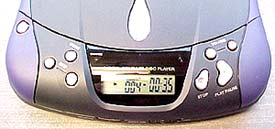One thing that this portable CD/MP3 player doesn't lack
is jacks... every imaginable jack is on this player; audio and video output
jacks, DC input jacks, and... no wait that's it. As we mentioned before one of
the strange aspects of the player is its power button, which lets you choose
from either On (battery), off, or ON (Direct from the AC adapter) - rather than
one simple on/off switch that automatically detects if the unit is plugged into
the wall.
In any regards the unit comes standard with a 3.6V
1400mAh battery pack, that is rechargeable. It takes about 2 hours to recharge the battery. Because the unit can play Video CD's, there is a video
output on the side where a special audio jack plugs in, and splits the
signal into an RCA jack which can be hooked up to a TV or VCR. Likewise
in this configuration, the Audio jack splits off into a left and right channel RCA jack. When
the DAV309 is hooked up to a VCR or TV, the remote is used to
control the playback of the VCD.
The LCD Display:
The heart of every portable CD/Mp3 Player on the market
is the LCD display, which tells you what track you're on, and usually how long
the song is, if the player is on random, or any other specifics. Due to the
compression of the MP3 format, more than the standard 20 or so songs will fit
onto one CD. Depending on the compression and sampling rate its is possible to
have hundreds, or many hundreds of songs on one CDRW. As such, Napa DAV309 track
display is of the three digit variety. However, the display is crowded with
numbers and the "play", "pause" and "stop" icons are about
3mm wide at the largest - suffice to say, they are difficult to read. There
is no back-light for the display. Acronyms for "intro" (plays the first few seconds of each
track), "all" (I plays all tracks I guess...?) and "random" are squeezed in where they'll fit. As a
side comment, the instructions proudly proclaim the inclusion of the LCD display, but do not
explain a single feature of it!
 |
 |
 The controls for the DAV309 are labeled and easy to operate. Other than the
Bass boost, and power switch they are all located on the face of the player.
Volume is controlled by two small buttons directly above the play/pause and stop
switches. A good location, but a bit cramped as far as layout goes. No visual
indication of volume level is displayed anywhere on the unit. At the highest
volume the headphones that come standard with the unit become distorted. Both a
testament to the volume levels on the unit and the substandard earphones which
hook up to the unit.
The controls for the DAV309 are labeled and easy to operate. Other than the
Bass boost, and power switch they are all located on the face of the player.
Volume is controlled by two small buttons directly above the play/pause and stop
switches. A good location, but a bit cramped as far as layout goes. No visual
indication of volume level is displayed anywhere on the unit. At the highest
volume the headphones that come standard with the unit become distorted. Both a
testament to the volume levels on the unit and the substandard earphones which
hook up to the unit.
